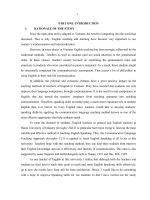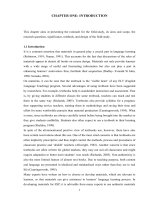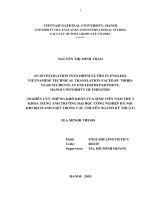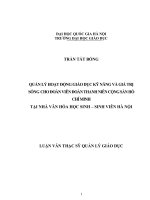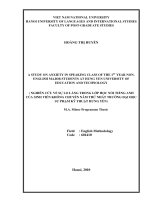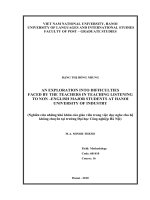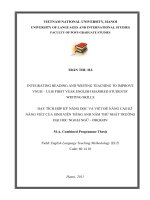Nghiên cứu thực trạng dạy kỹ năng nghe cho sinh viên không chuyên năm thứ 2 trường đại học công nghiệp hà nội khó khăn và một số giải pháp đề xuất
Bạn đang xem bản rút gọn của tài liệu. Xem và tải ngay bản đầy đủ của tài liệu tại đây (299.38 KB, 12 trang )
VIETNAM NATIONAL UNIVERSITY, HANOI
UNIVERSITY OF LANGUAGES AND INTERNATIONAL STUDIES
FACULTY OF POST- GRADUATE STUDIES
----- -----
ĐỖ KIM THUỲ
A STUDY ON THE REALITY OF TEACHING LISTENING SKILLS
TO SECOND-YEAR NON-ENGLISH MAJOR STUDENTS AT HANOI
UNIVERSITY OF INDUSTRY: RELEVANT PROBLEMS
AND SOME SUGGESTED SOLUTIONS
Nghiên cứu thực trạng dạy kỹ năng nghe cho sinh viên không chuyên
năm thứ 2 trường Đại học Công nghiệp Hà Nội: Khó khăn
và một số giải pháp đề xuất
M.A. Minor Programme Thesis
Field: English Teaching Methodology
Code: 60140111
HA NOI – 2015
VIETNAM NATIONAL UNIVERSITY, HANOI
UNIVERSITY OF LANGUAGES AND INTERNATIONAL STUDIES
FACULTY OF POST- GRADUATE STUDIES
----- -----
ĐỖ KIM THUỲ
A STUDY ON THE REALITY OF TEACHING LISTENING SKILLS
TO SECOND-YEAR NON-ENGLISH MAJOR STUDENTS AT HANOI
UNIVERSITY OF INDUSTRY: RELEVANT PROBLEMS
AND SOME SUGGESTED SOLUTIONS
Nghiên cứu thực trạng dạy kỹ năng nghe cho sinh viên không chuyên
năm thứ 2 trường Đại học Công nghiệp Hà Nội: Khó khăn
và một số giải pháp đề xuất
M.A. Minor Programme Thesis
Field: English Teaching Methodology
Code: 60140111
Supervisor: PhD. Mai Thi Loan
HA NOI – 2015
DECLARATION
I certify that the minor thesis entitled “A study on the reality of teaching
listening skills to second-year non-English major students at Hanoi University of
Industry: Relevant problems and some suggested solutions” is my own work and
has not been submitted in any form for another degree to any other university or
institution.
Hanoi, November 2015
Do Kim Thuy
1
ACKNOWLEDGMENTS
In the completion of this thesis, I have received valuable supports from many
individuals and groups.
First and foremost, I wish to express my deepest gratitude to my supervisor,
Mrs. Mai Thi Loan, PhD. for providing careful guidance, thorough encouragement,
valuable comments and constructive supervision throughout my study. Without her
deliberate help, my thesis would not have been completed.
I would like to show my sincere thanks to all the lecturers who have been
engaged in teaching K22 M.A. course for their precious lectures.
My special thanks also go to my colleagues and students at Hanoi University
of Industry for willingly participating in the study.
Furthermore, I owe my great acknowledgment to my parents, my husband, my
son and my friends who unceasingly gave me encouragement and support
throughout the study.
Eventually, this research has been fulfilled to the best of my knowledge;
however, mistakes and shortcomings are unavoidable. Therefore, I exceedingly
appreciate comments and suggestions from any readers for the perfection of this
work.
Hanoi, November 2015
Do Kim Thuy
2
ABSTRACT
This study was conducted to investigate the reality of teaching listening skills
at Hanoi University of Industry (HaUI). To collect relatively objective information,
a combination of both qualitative and quantitative approaches was used. Data
collection instruments consisted of questionnaires- one for teachers and one for
students, and class observations. The findings pointed out that teachers and secondyear non-English major students at HaUI were encountering many difficulties in
teaching and learning listening such as students’ low listening competency,
students’ limited vocabulary and students’ poor background knowledge. Some
suggestions were made by the teachers and the students to improve the current
situation of teaching listening skills at HaUI including using different motivating
activities to motivate students; having students work in pairs/groups and do
different tasks and guiding students what and how to do without understanding all
the text. At last, the researcher gave some recommendations for effective listening
lessons.
3
LIST OF ABBRIVIATION
EFL: English as foreign language
HaUI: Hanoi university of Industry
4
PART A: INTRODUCTION
1. Rationale of the study
Listening plays an important role in everyday communication and educational
process. In our daily lives, we spend far more time listening than speaking, reading
or writing (Morley, 1991). However, in many language classrooms, listening is
somehow seen as a lesser skill. We must admit that speaking does not of itself
constitute communication unless what is said is comprehended by another person.
This shows the importance of listening comprehension, and implies that teachers
need to distribute a considerable amount of classroom time to teaching and
practicing it.
In reality, in many universities in Vietnam in general and in HaUI in
particular, teaching English listening skills has not been paid much attention to. As
a result, the qualities and effectiveness of teaching and learning these skills are not
really as good and high as expected.
In teaching listening, I encounter several difficulties such as large classes,
learners with lots of different learning styles and diverse needs, etc. Besides, my
colleagues also complain a lot about their problems. Hence, it is necessary to find
out the effective ways for the teachers at HaUI to improve their teaching bringing
better result in learning for students.
The above situations has inspired me to do the research entitled “A study on
the reality of teaching listening skills to the second-year non-English major students
at Hanoi University of Industry: Relevant problems and some suggested solutions”
with the hope of making some contributions to improving the teaching and learning
of English listening skills at HaUI.
2. Aims of the study
The study aims to investigate:
The current situation of teaching English listening skills to the second-year
non-English major students at HaUI;
Teachers’ and students’ difficulties in teaching and learning listening skills;
5
Suggested solutions for improving teaching listening skills for second-year
non-English major students at HaUI.
3. Research questions
To achieve the aims of the study, we tend to seek answers for these questions:
1. What is the reality of teaching listening skills for the second-year non-English
major students at HaUI?
2. What difficulties do EFL teachers and students encounter in teaching and
learning listening skills?
3. What are the solutions for improving the quality of teaching listening to the
second-year non-English major students at HaUI?
4. Scope of the study
This study is limited to the reality of teaching listening skills to second-year
non-English major students at HaUI. Any investigation into other skills such as
reading, writing or speaking is out of the scope of this study.
This study is conducted to a specific object at HaUI; therefore, it is not
expected to be generalized to other school contexts. However, it may be a useful
reference material for those who encounter the same problems in teaching listening
skills.
5. Methods of the study
This study was designed to use both quantitative and qualitative methods.
Firstly, the quantitative method was applied with the use of questionnaires
delivered to teachers and students to find out the reality of teaching listening skills
at HaUI, the difficulties of the teachers and the students in teaching and learning
listening skills and their solutions for better teaching and learning this skill.
Together with this, qualitative method was conducted with classroom observations.
This was a necessary step for the researcher to double-check what was actually
happening in listening lessons. Besides, the researcher also reviewed related
documents for the establishment of the theoretical background for the study.
6
REFERENCES
1. Abbas, P.G. (2011). A study of factors affecting EFL learners' English listening
comprehension and the strategies for improvement. Journal of language
teaching and research, Volume 2, Issue 5, p.977-988. Academy publisher
manufactured in Finland.
2. Arono, A. (2014). Improving students listening skill through interactive
multimedia in Indonesia. Journal of language teaching and research, Volume
5, Issue 1, p.63-69.
3. Barker, L., Edwards, R., Gaines, C., Gladney, K., & Holley, F. (1980). An
investigation of proportional time spent in various communication activities by
college students. Journal of applied communication research, 8, p.101-110.
4. Brown, S. (2006). Teaching listening. Cambridge: Cambridge University Press.
5. Buck, G. (2001). Assessing listening. Cambridge: Cambridge University Press.
6. Celce-Murcia & Marianne (2001). Teaching English as a second or foreign
language. Cambridge: Cambridge University Press.
7. Christine, C. M. G., & Vahid, A. (2015). Examining the notion of listening
subskill divisibility and its implications for second language listening.
International journal of listening, Volume 29, Issue 3, p.109-133.
8. Coakley, C., & Wolvin, A. (1997). Listening in the educational environment. In
M. Purdy & D. Borisoff (Eds.). Listening in everyday life: A personal and
professional approach (2nd ed.) (p.179-212). Lanham, MD: University Press of
America.
9. Đào Thị Ngân (2012). The reality of teaching and learning English listening
skills in grade 10 at Yen Mo B High School, Ninh Binh province. Unpublished
MA. Thesis, ULIS, VNU.
10. Franca, F. B., Rosanne, V., & Barbara, L. (2015). Fostering and assessing
critical listening skills in the speech course. International journal of listening,
Volume 5, Issue 3, p.161-169. Oxford Press.
7
11. Gilbert, M. B. (1988). Listening in school: I know you can hear me- but
are you listening? Journal of the international listening association.2. p.121132.
12. Hasan, A.S. (1993). Methodology of teaching English. Damascus: Damacus
University.
13. Hedge, T. (2000). Teaching and learning in the language classroom. Oxford:
Oxford University Press.
14. Hoàng Thị Thanh Minh (2013). The problems faced by teachers and first year
non-English major students at Sao Do University in teaching and learning
English listening skill and some solutions. Unpublished MA. Thesis, ULIS,
VNU.
15. Howatt, A., & J. Dakin (1974). Language laboratory materials. Oxford
University Press.
16. Jan, H. (2015). Connectionist model of language processing and the training of
listening skills with the aid of multimedia software. International journal of
listening, Volume 16, Issue 5, p.413-425.
17. John, F. (2015). Skills and strategies: towards a new methodology for listening.
Oxford journals, Volume 52, Issue 2, p.110-118.
18. Karl, L. S., & Richard, F. (2013). Developing effective interpersonal
communication and discussion skills. International journal of listening, Volume
69, p.276-283.
19. Kaufmann, T., Sterkens, J., & Woodgate, J. M. (2015). Hearing loops, the
preferred assistive listening technology. Journal of the AES, Volume 63, Issue
4, p.298-302.
20. Liz, Soars, J., & Wheeldon, S. (2000). New-headway series, third edition.
Oxford University Press.
21. Magnus, W. (2015). Discovery listening - Improving perceptual processing.
ELT journal, Volume 57, Issue 4, p.335-343.
8
22. Morley, J. (1999). Current perspectives on improving aural comprehension.
Retrieved
on
20th
September,
2015
from
/>23. Mulvany, S. (2015). Improving listening skills. Journal of property
management, Volume 23, Issue 11, p.7-11.
24. Nguyễn Thị Hyền (2014). Using movies to increase motivation and listening
comprehension of Third year EFL students at Academy of Finance: An action
research study. Unpublished MA. Thesis, ULIS, VNU.
25. Peter, C., Fontana, Steven, D., Cohen, Andrew D., & Wolvin (2015).
Understanding listening competency: A systematic review of research scales.
International journal of listening, Volume 29, Issue 3, p.148-176.
26. Seliger, H.W., & Shohamy, E. (1995). Second language research methods (3rd
ed). Oxford: OUP
27. Shao-Wen Su &Chung-Hsiang Liu (2014). Teaching listening comprehension
skills: A test-orientated approach. Journal of language teaching and research,
Vol 3, Issue 3, p.458-465.
28. Underwood, M. (1989). Teaching listening. New York: Longman.
29. Ur, P. (1984). Teaching of English as a second or foreign language.
Cambridge: Cambridge University Press.
30. Vandergrift, L. (1999). Facilitating second language listening comprehension:
Acquiring successful strategies. ELT journal, Volume 53, Issue 3, p.168-176.
Oxford Press.
31. Wolvin, A. D., & Coakley, C. G. (1988). Listening (3rd ed.). Dubuque, IA:
Wm. C. Brown.
32. Yagang, F. (1993). Listening: problems and solutions. Forum, 31/1. Retrieved
on
20th
September,
/>
9
2015
from
I
